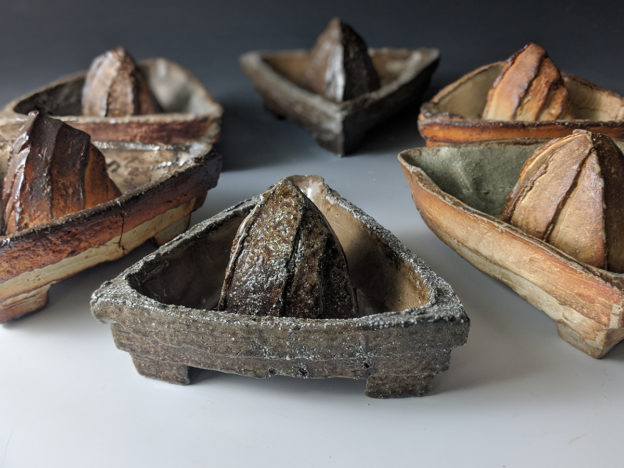I am a nester and a creature of habit. I don’t think of myself as particularly materialistic, but if you’re eying my favorite mug you’d best step off.
Most of my favorite things are handmade – which is sad because when you accidentally smash them to smithereens they’re really hard to replace. I have gotten better with dealing with this kind of loss since having kids. When something breaks, I want to make sure I’m sending the right message – people first, things second.
But this is not about breaking things. This is about making them.
A few years ago I had the opportunity to work with several potters in creating an exhibit of their work. Talking to them was great because it made me feel less crazy about my rabid attachment to certain bowls and mugs.
Potter Laura Ross told me she feels she could “spend a lifetime making pots just to create one of those few cups or bowls in the kitchen cabinet which is chosen each morning. It is my intent to make pottery which is selected because it functions effortlessly in the dance of daily use as well as having an energy and life force that makes a connection with the user. The freshness and spontaneity of cut clay, ragged edges, and undulating rims, combined with the accidental quality of the flame patterns, impart an energy and spiritual edge that I want in my work. My pots are made to reflect the traditional values of fine craftsmanship, integrity of form, and usage to enliven our daily rituals.”
Enliven our daily rituals.
That seems to be a common theme among these sorts. Sequoia Miller says “handmade objects have a particular point of view that is a combination of the maker, the material, and the user. Using handmade anything simply gives you more to respond to. It’s like riding a horse versus driving a car, only much less inconvenient.”
I know there’s an element of autopilot with any kind of work, but there’s something great about people who enter the studio with a happy heart and the intention of making something for someone else to use.
Over and over, people talked about judging their own work by how frequently it was used. Not put on a shelf and admired. Not given awards. Used.
Is that what it is about these pieces? The hopes of the maker?
Potter Ben Krupka uses his own work as well as pottery made by friends. “Each piece has its own personality,” he says, “just like people. It makes beverages better when housed in a handmade cup or mug. It is a way of bringing art into daily life. Really, if you think about it, there aren’t many things we put to our lips. We use them to kiss and things like that, which make our lips a very sensual part of us. So I guess you have to treat them well. Why take such a sensual object and put a Styrofoam or paper cup to them?”
These people not only bring an element of art into everyday life, they make everyday things more human. There’s a connection between the maker and the user.
In a Gazette news clip about POW!, a collaborative group of potters including Sam Taylor and Mark Shapiro, one 11 year old said of a handmade pot, “It just felt good in my hands and like someone actually made it for me to pick up.”
So I’m not rabidly attached to a piece of clay – formed, fired and made functional. I’m attached to the idea that someone somewhere wanted to make life more personal and thought about the end user when they set about their work.
May we all do some of that when we go to work.
A version of this column originally appeared in The Magazine of Yoga, and is reposted with permission. It was the first in a series on practice.
Photo: Juicers, by Sam Taylor

